
With this installment of Conservation Corner, I thought I'd take a look at an interesting group of North American native fishes that make really excellent aquarium specimens, and some of which are seriously imperiled.
The pygmy sunfishes are a genus of seven small fishes found throughout the southeastern United States. Despite the common name, they are not actually sunfishes – in fact, there's been a heck of a lot of argument about just what they are! Like sunfishes (and bass), they were once considered cichlids. Pygmy sunfish have been thought to be closely related to killifish, sunfish, and even pipefish – but, ultimately, the pygmy sunfishes have been shown to be sufficiently unique to be placed within their own family, Elassomatidae.
Click image to enlarge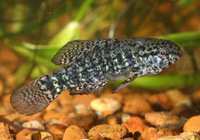
The first pygmy sunfish described, the banded pygmy sunfish, Elassoma zonatum, is probably the easiest to maintain.
Photo courtesy Supervillain Stan Sung 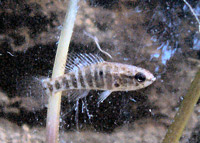
One of the most commonly kept pygmy sunfishes is the Everglades pygmy sunfish, Elassoma evergladei, found in weedy streams throughout Florida.
Photo courtesy Joshua WiegertPygmy sunfish inhabit slow flowing, weed-choked areas of water. They can be found in drainage ditches, swampy areas, or streams. They are fairly small fishes, with all species reaching about an inch or so in size. Pygmy sunfish can be somewhat difficult to feed in the aquarium, often demanding small live foods, such as blackworms or Daphnia, but generally transition to at least frozen fish food.
Pygmy sunfish do quite well in planted aquaria, and will thrive in small fish aquariums. They mix well with a lot of our small tropical fishes, making great tankmates with pencilfish, small tetras, or mini rasboras. Provided their tankmates will not eat them and are not voracious enough to gobble down all the fish food, they'll do just fine. Like many of our tropical fish, pygmy sunfish do best in soft, acidic water.
Breeding behavior is similar for all seven species of pygmy sunfishes. Males are generally smaller and more brightly colored than the relatively plain females. The males become more intensely colored as they prepare to spawn, with the females growing fat. Males will set up small territories around bundles of plants, or spawning mops, and attract females to them. A mating dance follows, at which time eggs are deposited in the plants. The male will generally drive the female away and then guard the cluster until hatching. The female may eat the eggs.
The banded pygmy sunfish, Elassoma zonatum, was the first described species of pygmy sunfish, described by Jordan in 1877. It is the biggest of the species, reaching about 1.5 inches in aquaria. It is wide ranging, found from North Carolina south to Florida, and from Texas to Illinois. It is found in swampy water, among vegetation. The banded pygmy sunfish is olive green with dark bands over much of the body, its fins are brightly speckled. It is probably the easiest of the species to find, collect, and keep in aquaria.
A few years after the discovery of the banded pygmy, the Everglades pygmy sunfish(E. evergladei) was described. It is found in Florida, from the Everglades to southern North Carolina and Alabama. The Everglades pygmy sunfish can be found anywhere there are a lot of submerged aquatic plants, often mixed with Gambusia and small killifish. It is a fairly small fish, rarely reaching much beyond an inch. It is very colorful, with translucent blue diamond markings throughout the body, giving it a striking appearance. However, the Everglades pygmy sunfish is incredibly finicky in the aquarium, and often wastes away. While it is a pretty fish, I personally don't bother keeping them.
Click image to enlarge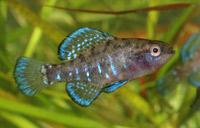
The beautiful Okefenokee pygmy sunfish, Elassoma okenfenokee, has a very restricted range, but is worth the trouble. Photo courtesy Supervillain Stan Sung 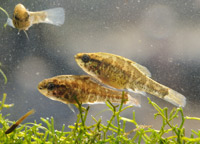
The Alabama pygmy sunfish, Elassoma alabamae, is found in only a few springs and may not survive long enough to be officially listed as Endangered.
Photo courtesy Emily Y. Horton In 1956, the Okefenokee pygmy sunfish (E. okefenokee) was described. The Okefenokee pygmy sunfish has a relatively small range, making it somewhat difficult to find. It occurs in Georgia and Florida. This is, without a doubt, the most beautiful of the species. It’s an olive green color fish with brownish-red mottling across the body, mixed with bright blue.
While the previous three species of Elassoma are all available to aquarists, the remaining four are unfortunately not – or at least should not be. All four of these pygmy sunfish have small populations and are either listed as endangered or are on the list for evaluation. While it’s technically not illegal to collect and maintain a fish that isn't listed yet, it is quite unethical for aquarists to take advantage of the Speed of Bureaucracy (SOB, an acronym that describes most bureaucrats admirably).
In 1987, the Carolina pygmy sunfish (E. boehlkei) and the bluebarred pygmy sunfish (E. okatie) were both described, both from the Carolinas, with the bluebarred having a far more restricted range. The Carolina pygmy sunfish is a very pretty fish, with a dark body covered in speckles of blue and yellow. The bluebarred pygmy sunfish occurs in such a small area and is so rare that I couldn't even find a photo to describe it from – nor have I ever seen the fish in the flesh. Both species are listed as Endangered Species.
In 1993, the Alabama pygmy sunfish (E. alabamae) was added to the genus. It is a gorgeous fish. It is a dark colored fish with blue speckles all over the body, giving it a jeweled appearance. It is endemic to Moss Springs in Alabama. It was historically found in several adjacent springs, but has been extirpated. Its current range seems limited to in and around Beaverdam Creek, near Huntsville, Alabama.
The Alabama pygmy sunfish used to have a larger range – and historically, the range may have been quite larger. Unfortunately, the Huntsville area continues to grow, and suburban sprawl is gobbling up the available habitat. Bruce Stallsmith, of the North American Native Fishes Association (NANFA), reports that the stream it is found in is now “bisected with a new sewer line in preparation for an expansion of both residential and industrial uses. The construction of this sewer line destroyed large areas of riparian vegetation, and caused widespread siltation in springs that typically run clear.” As a result of this sewer line's construction, the habitat has been separated into small sections, creating subpopulations that cannot interbreed. This separation will result in extreme genetic degradation and inbreeding. Groundwater usage is continuing to rob the springs of water, and they may run dry in the near future.
Unfortunately, the Alabama pygmy sunfish is just now undergoing the petition process to be added to the Endangered Species list. This sunfish will undoubtedly be gone by the time it is successfully listed. NANFA has petitioned the United States Fish and Wildlife Services to emergency list E. alabamae (see final paragraph).
Most recently, in 2007, E. gilberti was described – so recently that no one has bothered to give it a common name yet. It is found in Northern Florida, and slightly into Georgia. This is a pretty sunfish, very similar to E. okefenokee. The population seems to be fairly secure, and it may make an interesting aquarium fish – it’s too recently discovered to know for sure though.
The fishes of the genus Elassoma are beautiful, interesting, and small fishes that can make great additions to the aquarium. Several of the species are, unfortunately, threatened by continued habitat degradation. As suburban and urban sprawl continues, their streams and swamps are drained, bulldozed, or just polluted until they are unable to sustain the fish. These fish are well worth conserving.
I urge concerned aquarists to contact the USFWS and ask that E. alabamae be emergency listed. Write to Ms. Janet Mizzi, USFWS Southeast Region Headquarters, 1875 Century Boulevard Suite 4000, Atlanta, GA, 30345. For more information on the North American Native Fishes Association, visit www.nanfa.org.
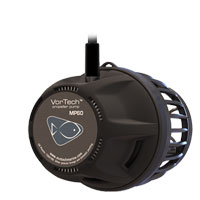 EcoTech Marine, Eheim, and Rolf C. Hagen (USA) Corp. Win Pet Product News International Editors Choice Awards
EcoTech Marine VorTech MP60.
Eheims Aquastyle Aquarium.
EcoTech Marine, Eheim, and Rolf C. Hagen (USA) Corp. Win Pet Product News International Editors Choice Awards
EcoTech Marine VorTech MP60.
Eheims Aquastyle Aquarium.
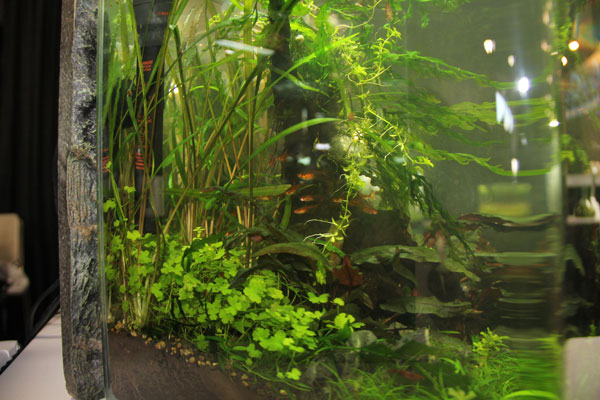 Innovations in the Aquarium Hobby
Fishkeeping has experienced a lot of progress throughout the
Innovations in the Aquarium Hobby
Fishkeeping has experienced a lot of progress throughout the
 Aquarium Fish Hiding Places
Imagine having to spend an extended period in a room w
Aquarium Fish Hiding Places
Imagine having to spend an extended period in a room w
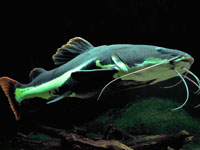 Red-Tailed Catfish in Home Aquariums
Q. The owner of my local fish store (LFS) sold me a red-tail
Red-Tailed Catfish in Home Aquariums
Q. The owner of my local fish store (LFS) sold me a red-tail
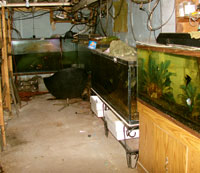 Custom Aquarium Setup
I wonder, is your setup like mine? The answer is proba
Custom Aquarium Setup
I wonder, is your setup like mine? The answer is proba
Copyright © 2005-2016 Pet Information All Rights Reserved
Contact us: www162date@outlook.com